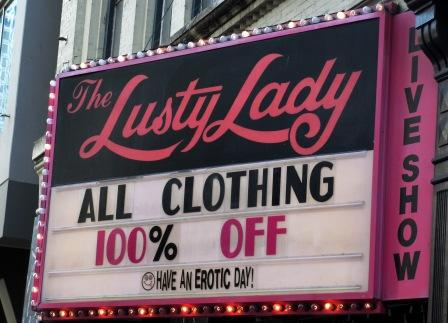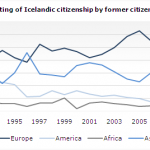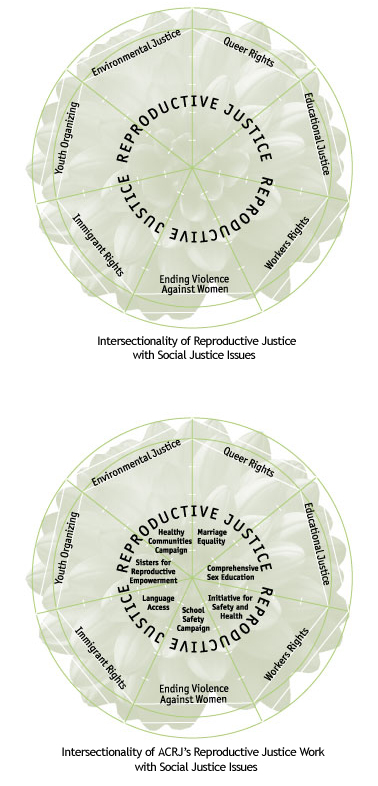We welcome this guest post from Carly Chillmon, a Ph.D. candidate in sociology at University of California, Santa Barbara.
—————————————–
 When I began constructing my dissertation project in the fall of 2008, I was met with one recurring response, “You should check out the Lusty Lady.” I was developing a study to examine how legal sex businesses are regulated and operate within the urban setting of Seattle. In my research the majority of people I have spoken with identify the Lusty Lady (a woman-managed peep show) as a true Seattle gem… a last-stand to Seattle’s not-so-metronatural past. Sadly, this beacon of sexual expression announced on April 11, 2010, that it would be closing for business in June.
When I began constructing my dissertation project in the fall of 2008, I was met with one recurring response, “You should check out the Lusty Lady.” I was developing a study to examine how legal sex businesses are regulated and operate within the urban setting of Seattle. In my research the majority of people I have spoken with identify the Lusty Lady (a woman-managed peep show) as a true Seattle gem… a last-stand to Seattle’s not-so-metronatural past. Sadly, this beacon of sexual expression announced on April 11, 2010, that it would be closing for business in June.
While in many instances adult entertainment is met with contention with those who don the cloak of moral superiority, the Lusty Lady did not meet such policing. In fact, Assistant Chief Jim Pugel of the Seattle Police Department told me that,
“…I can’t recall the last time we had a complaint of a robbery, of a drug deal, or any other activity that is usually associated or part and parcel with prostitution or people engaged in vice.” — Seattle Chief of Police, Jim Pugel
In other words, the Lusty Lady maintained its status of a legal business without ties to criminality and vice. The Lusty Lady’s humorous billboards also helped bridge the social distance and discomfort that often exists between the sex industry and the broader public. In my same interview with the Seattle Chief of Police Pugel, the Chief said that “.. their billboards are just the best billboards you’ve ever seen.”
At a time when freedom of speech is often in need of defense, the Lusty Lady openly expresses sexuality in an engaging and often topical tongue-in-cheek fashion. Passersby on 1st Avenue are met with such greetings as “We Takeoff More Than Boeing,” “Business Doing Pleasure,” “We Give Raises,” and one of my timely favorites, “Check Our Stimulus Package.” The pink and black marquee offers a sense of humor and a savvy way to make people think, even for just a moment, about sexual desire.
When I spoke with local politicians about the regulation of legal sex businesses, the Lusty Lady was consistently noted as something special. Seattle City Council Member Tim Burgess stated,
“The Lusty Lady is interesting because it is kind of iconic in a way and I think that’s because of their billboard…”
Burgess went on to note that:
“…That might not be my choice of a business to patronize or to run clearly but I don’t think it’s the government’s role to get engaged there. As long as they’re not breaking the law and as long as they’re keeping a clean facility and getting along with their neighbors and they’re policing themselves, then I have no reason to question them or get involved with them.”
Council Member Burgess demonstrates an understanding of the legality of the business and a marked absence of complaint as a means to justify the existence of an establishment that he may personally not patron but politically accommodates.
Former City Council Member Peter Steinbrueck reflected on the relationship of the Lusty Lady to its across the street neighbor, the Seattle Art Museum. In his interview with me he said,
“In a quirky way, the Lusty Lady was accepted as sort of living art right next to the art museum. They have a small billboard, a marquee over the entrance, and they put artful little messages up there that can be seen from the galleries of the Seattle Art Museum so there is a funny kind of
relationship there that is, I think, mutually acceptable…It seen as part of the cultural life of the city basically…They (the Lusty Lady) were there before the art museum and they are part of the neighborhood.”
Through its play on words, the Lusty Lady was able to enhance its status and move away from the usual connection to deviance and stigma that is associated with adult entertainment. The Lusty Lady was able to move towards a place of cultural significance and artful appreciation.
However, such cultural standing is not resistant to the impact of the current economic recession. Management of the Lusty Lady reported through many local news outlets that they are a prime example of how the adult entertainment industry is not recession-proof (see articles by Kiley, Lacitis, and Cohen below). During these economic hard-times when many local small downtown businesses are closing, the Lusty Lady is just one of many casualties. Coupled with the rise of access to free pornography on the Internet, we can better understand why the Lusty Lady’s income dramatically dropped from the late 1990s to today.
It is also important to understand that this particular neighborhood has been undergoing dramatic change since the 1970s. The Pike Place Market preservation and development project, an influx of investment into real estate, particularly high-rise developments and office space, and a general evacuation of Seattle’s Flesh Avenue greatly altered this city’s landscape.
City Council Member Jean Godden, a former Seattle Times columnist, referred to the changing landscape of downtown Seattle, specifically of the changes that occurred along 1st Avenue. She stated,
“It (the Lusty Lady) is sort of the last bastion. There really isn’t much anymore… It’s very different than it used to be ,
and 1st Avenue, in particular was the one that certainly has gentrified so to speak, if that is what one wants to consider it over the years.”
Peter Steinbrueck further sheds light on the the ways that downtown Seattle has changed: “There were sex shops…up and down 1st Avenue, there were multiple pawn shops, second-hand businesses, used clothing, and, I think, right next to the main entrance to the Market was a porn theater of some sort…That was the kind of neighborhood that it was. I guess it would be described as a little seedy.”
In contrast to its “seedy” past, Seattle now boasts a premiere art museum, a Four Seasons Hotel and Residences, and a revitalized Pike Place Market. And, until June, the Lusty Lady still stands as a reminder to Seattle’s history and as a contributor to its cultural development.
While many are quick to praise the creativity of its marquee, the lack of recognition of the work that goes on  within the Lusty Lady needs mentioning. As part of the material culture of Seattle, the Lusty Lady also holds symbolic meaning for many people. The lapse of comprehension that “real” work went on beyond that marquee is possibly another reason for the Lusty Lady’s demise besides the economic downturn and Internet access to porn.
within the Lusty Lady needs mentioning. As part of the material culture of Seattle, the Lusty Lady also holds symbolic meaning for many people. The lapse of comprehension that “real” work went on beyond that marquee is possibly another reason for the Lusty Lady’s demise besides the economic downturn and Internet access to porn.
Further research must be pursued to understand the nuances of sex work in the legal business world. Without scholarly investigation into how sexual spaces are regulated, zoned, and operated, we fall victim to using the lens of sex work as deviant rather than sex work as legitimate labor and business organizations. It is not only important to understand the sex industry at moments of moral panics, but is vital to recognize how these businesses operate under a set of specific socio-political and economic conditions.
The Lusty Lady is a Seattle landmark; all of us, even those who are neither patrons nor workers at the Lusty Lady, will experience a cultural loss when it is “clothed” for business.
business.
———————————————————-
Carly Chillmon is currently an adjunct professor of sociology in the department of Anthropology, Sociology, and Social Work at Seattle University. The working title for her dissertation is “The Regulation of Sex Businesses: Place, Policy, and Politics.”
Recommended links:
- “Lust’s End: The Lusty Lady to Close.” By Brendan Kiley. SLOG, April 11, 2010.
- “Lusty Lady Peep Show Going Bust After 27 Years.” By Erik Lacitis, Seattle Times, April 12, 2010.
- Lusty Lady Marquee
- “‘Thanks for the Mammaries!’ How Should Lusty Lady Say Goodbye.” By Monica Guzman, Seattle PI Blogs, April 13, 2010.
- “‘Lusty Lady’ Closing After Three Decades.” By Lindsay Cohen, Seattle PI Local, April 11, 2010
- “Lusty Lady: A Seattle Panoram.” By Cassandra Tate, HistoryLink.org, May 3, 2007.

















